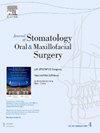Network pharmacology and experimental validation reveals the potential therapeutic effects of Polygonum cuspidatum against odontogenic keratocyst
IF 1.8
3区 医学
Q2 DENTISTRY, ORAL SURGERY & MEDICINE
Journal of Stomatology Oral and Maxillofacial Surgery
Pub Date : 2024-10-02
DOI:10.1016/j.jormas.2024.102105
引用次数: 0
Abstract
This study aimed to explore active ingredients in Polygonum cuspidatum with potential effects on odontogenic keratocysts (OKCs) using network pharmacological approach and bioinformatic gene analysis. The active ingredients and targets of P. cuspidatum were selected from the Traditional Chinese Medicine Systems Pharmacology Database and Analysis Platform (TCMSP) database, and the ingredient–target network was constructed using Cytoscape software. Differentially expressed genes (DEGs) of OKC were selected and Gene Ontology (GO) enrichment analysis were performed through bioinformatic analysis using Gene Expression Omnibus (GEO) dataset GSE38494. The STRING database platform was used to draw protein–protein interaction network diagram, then the hub gene analysis was performed by Cytoscape software. AutoDock Vina software was used to perform molecular docking verification of the effects of the active ingredients on potential core targets. Finally, we use OKC nude animal model to testify the potential effects of P. cuspidatum. Ten active ingredients of P. cuspidatum were obtained. A total of 205 drug targets and 38 potential core targets of P. cuspidatum were confirmed in OKCs. The hub genes included PPARG, SPP1, COL3A1, MMP2, HMOX1, CCL2, CXCL10, VCAM1, RUNX2 and IRF1. Molecular docking showed that the key active ingredients including luteolin and quercetin which exhibited good docking activity with key target proteins (VCAM1, HMOX1 and MMP2). GO enrichment revealed that the pathways of P. cuspidatum acting on OKCs included the response to toxic substance, response to nutrient levels and response to xenobiotic stimulus. P. cuspidatum treatment in OKC could significantly down-regulate COL3A1 and MMP2 expressions in vivo and vitro. Our study indicated that P. cuspidatum is a potential therapeutic candidate for OKCs.
网络药理学和实验验证揭示了何首乌对牙源性角化囊肿的潜在治疗效果。
本研究旨在利用网络药理学方法和生物信息学基因分析,探讨何首乌中对牙源性角化囊肿(OKCs)具有潜在作用的有效成分。从中药系统药理学数据库和分析平台(TCMSP)数据库中筛选出何首乌的有效成分和靶标,并使用Cytoscape软件构建成分-靶标网络。利用基因表达总库(Gene Expression Omnibus,GEO)数据集 GSE38494 进行生物信息学分析,筛选出 OKC 的差异表达基因(DEGs)并进行基因本体(Gene Ontology,GO)富集分析。利用 STRING 数据库平台绘制蛋白质-蛋白质相互作用网络图,然后利用 Cytoscape 软件进行枢纽基因分析。使用 AutoDock Vina 软件对活性成分对潜在核心靶点的影响进行分子对接验证。最后,我们使用 OKC 裸鼠动物模型来验证虎皮兰的潜在作用。结果表明,我们获得了 10 种虎皮兰的有效成分。在 OKC 中,共确认了 205 个药物靶点和 38 个潜在的核心靶点。中心基因包括 PPARG、SPP1、COL3A1、MMP2、HMOX1、CCL2、CXCL10、VCAM1、RUNX2 和 IRF1。分子对接显示,包括木犀草素和槲皮素在内的主要活性成分与关键靶蛋白(VCAM1、HMOX1 和 MMP2)具有良好的对接活性。GO富集显示,虎皮兰对OKCs的作用途径包括对毒性物质的反应、对营养水平的反应以及对异生物刺激的反应。在体内和体外,处理OKC的虎皮兰能显著下调COL3A1和MMP2的表达。我们的研究表明,虎皮兰是治疗 OKC 的潜在候选药物。
本文章由计算机程序翻译,如有差异,请以英文原文为准。
求助全文
约1分钟内获得全文
求助全文
来源期刊

Journal of Stomatology Oral and Maxillofacial Surgery
Surgery, Dentistry, Oral Surgery and Medicine, Otorhinolaryngology and Facial Plastic Surgery
CiteScore
2.30
自引率
9.10%
发文量
0
审稿时长
23 days
 求助内容:
求助内容: 应助结果提醒方式:
应助结果提醒方式:


